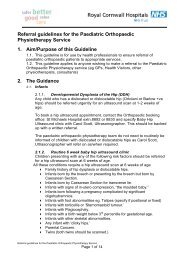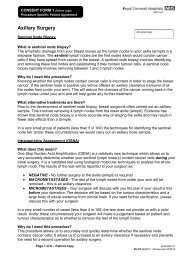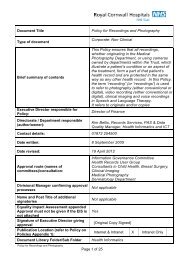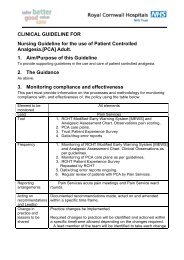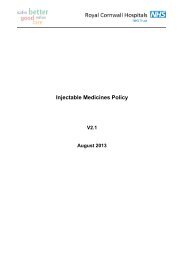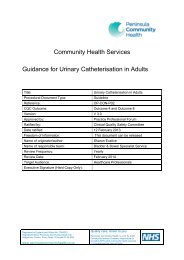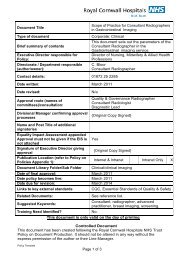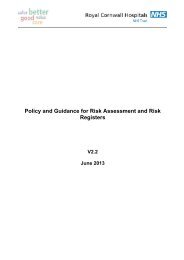(CVC) Management Guidance - the Royal Cornwall Hospitals Trust ...
(CVC) Management Guidance - the Royal Cornwall Hospitals Trust ...
(CVC) Management Guidance - the Royal Cornwall Hospitals Trust ...
You also want an ePaper? Increase the reach of your titles
YUMPU automatically turns print PDFs into web optimized ePapers that Google loves.
Appendix 5 Types of Central Venous Ca<strong>the</strong>ters<br />
<strong>CVC</strong> Device Use Picture Location Advantages Disadvantages<br />
Peripherally inserted<br />
central ca<strong>the</strong>ter<br />
(PICC)<br />
Non tunnelled central<br />
venous ca<strong>the</strong>ter<br />
e.g. Hohn ca<strong>the</strong>ter,<br />
Triple Iumen ca<strong>the</strong>ter<br />
Tunnelled central<br />
venous ca<strong>the</strong>ter<br />
e.g. Hickman,<br />
Groshong and<br />
Broviac line<br />
Inserted via <strong>the</strong><br />
antecubital veins in <strong>the</strong><br />
arm and advanced into<br />
central veins until <strong>the</strong> tip<br />
is in <strong>the</strong> superior vena<br />
cava. It’s position must<br />
be checked by chest X-<br />
ray<br />
Inserted directly into <strong>the</strong><br />
vein, <strong>the</strong>se devices are<br />
mainly used in <strong>the</strong>atres<br />
and intensive care units<br />
for <strong>the</strong>rapies of less<br />
than 3 weeks duration.<br />
It has a lifespan of 5-7<br />
days but can remain insitu<br />
for up to 14 days<br />
(check manufacturers<br />
instructions).<br />
Not placed directly into<br />
vein but are tunnelled<br />
through <strong>the</strong> skin for<br />
approx 5cm, <strong>the</strong> tunnel<br />
reduces <strong>the</strong> risk of<br />
infection.<br />
<br />
1.Ease of insertion and<br />
removal<br />
2.Fewer insertion<br />
complications<br />
3.Low incidence of<br />
related<br />
infection/thrombosis<br />
4. Can be used in home<br />
setting<br />
1.Can be inserted at<br />
bedside<br />
2. Good access, several<br />
lumens<br />
3. High flow continuous<br />
access<br />
1.Low infection rate<br />
2.Patient comfort<br />
3. No external fixation<br />
4. Long term<br />
1. Smaller lumen/flow<br />
2. Mechanical Phlebitis at<br />
insertion site<br />
3. Problems with kinking<br />
1. Highest rate of all <strong>CVC</strong><br />
infections<br />
2. Requires external sutures<br />
3. Uncomfortable for patients<br />
4. Requires frequent changing 5-7<br />
days<br />
5. Difficulty maintaining<br />
exit/dressing site<br />
1. Surgical incision<br />
2. Requires surgical removal<br />
3. External portion of ca<strong>the</strong>ter<br />
visible<br />
Subcutaneous Port<br />
e.g. Port-a-cath<br />
Totally implanted<br />
vascular access device<br />
that is inserted into <strong>the</strong><br />
chest wall, lower<br />
ribcage or antecubital<br />
area. The port is<br />
accessed via a noncoring<br />
(huber point)<br />
needle.<br />
Error!<br />
<br />
1. Patient comfort no<br />
external sutures<br />
2. No exit dressing<br />
required<br />
3. Requires less<br />
maintenance<br />
1. Use of needle to access port<br />
2. Local skin ulceration through<br />
repeated use<br />
3. Shorter life span than a<br />
tunnelled <strong>CVC</strong><br />
4. Requires surgical removal<br />
24 of 25




